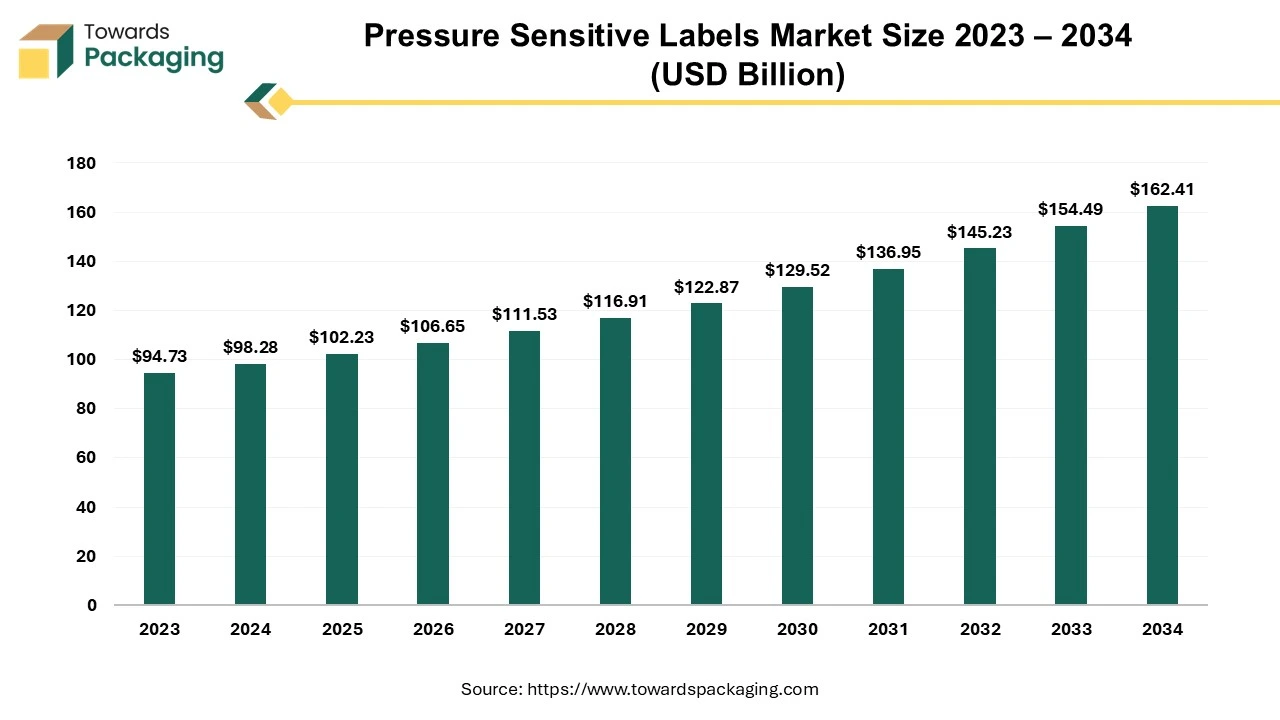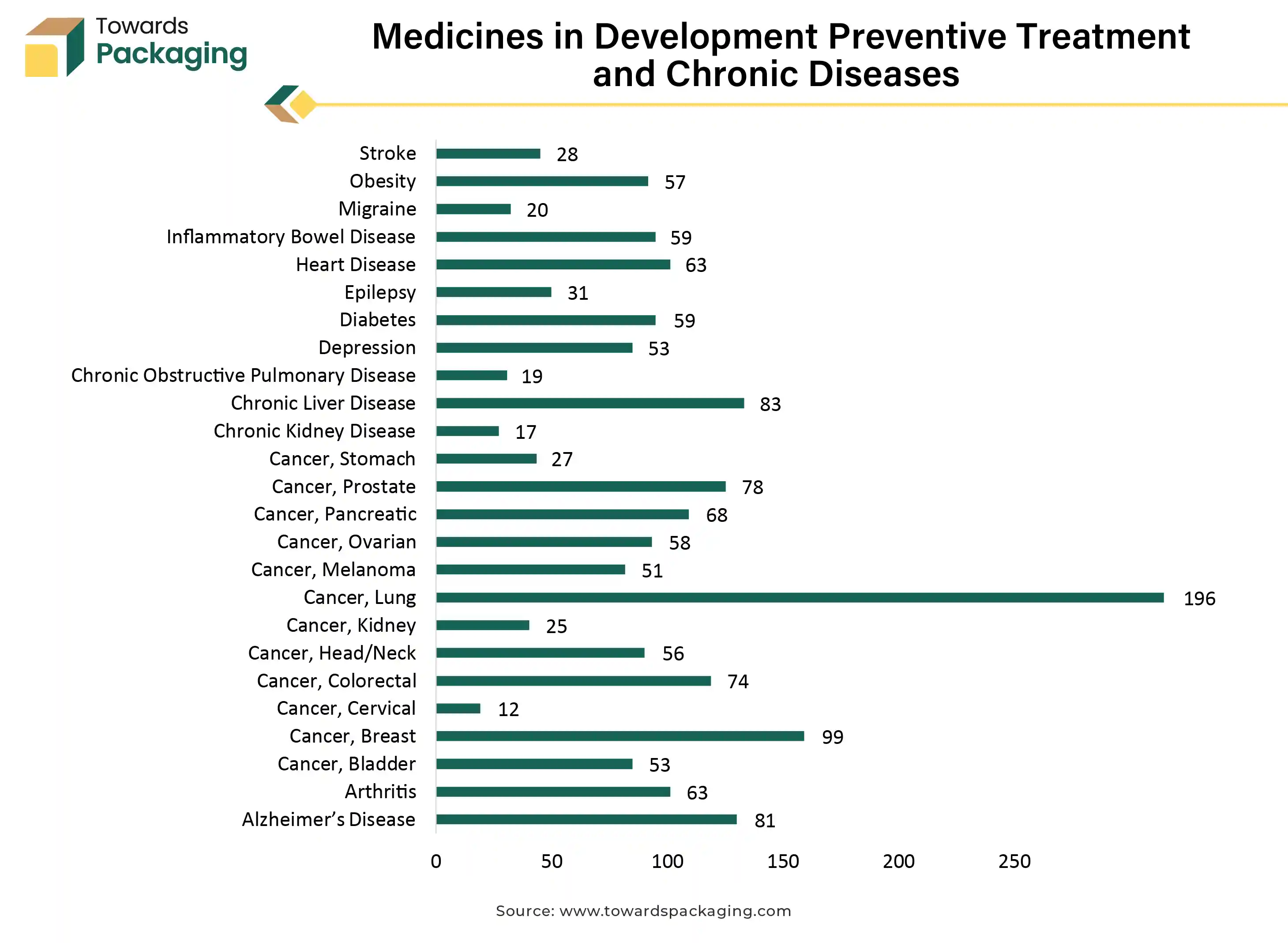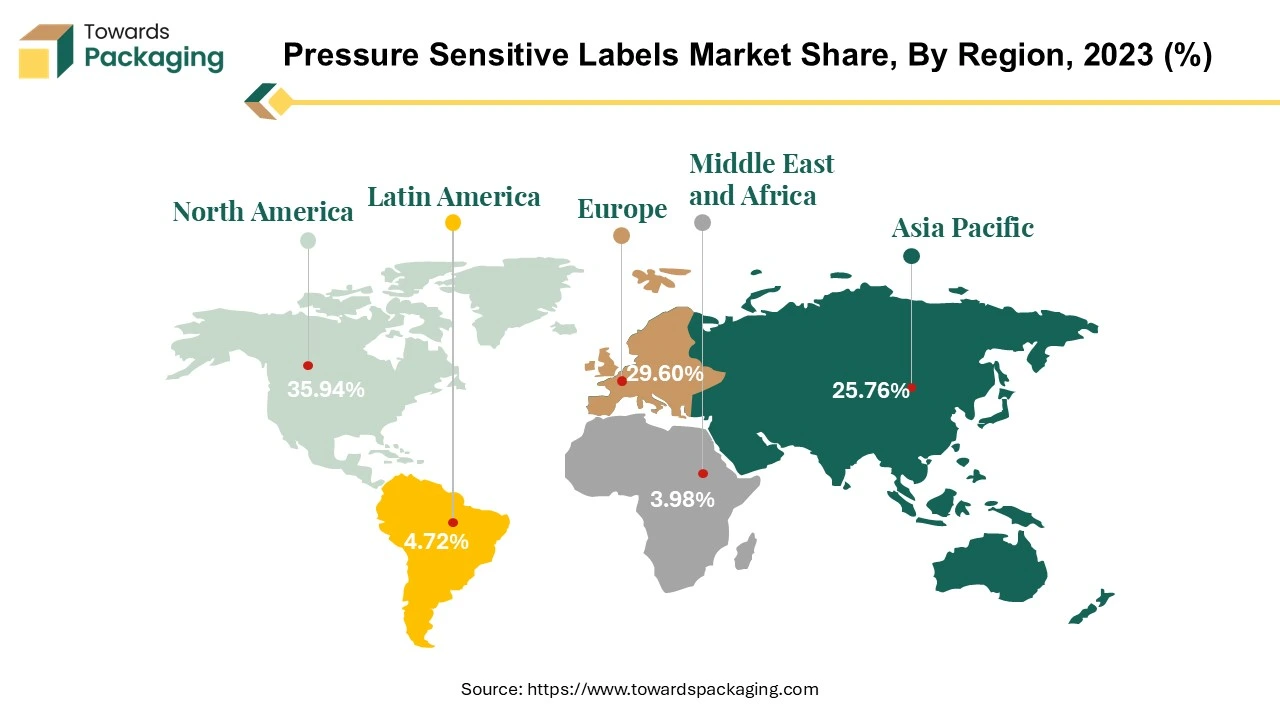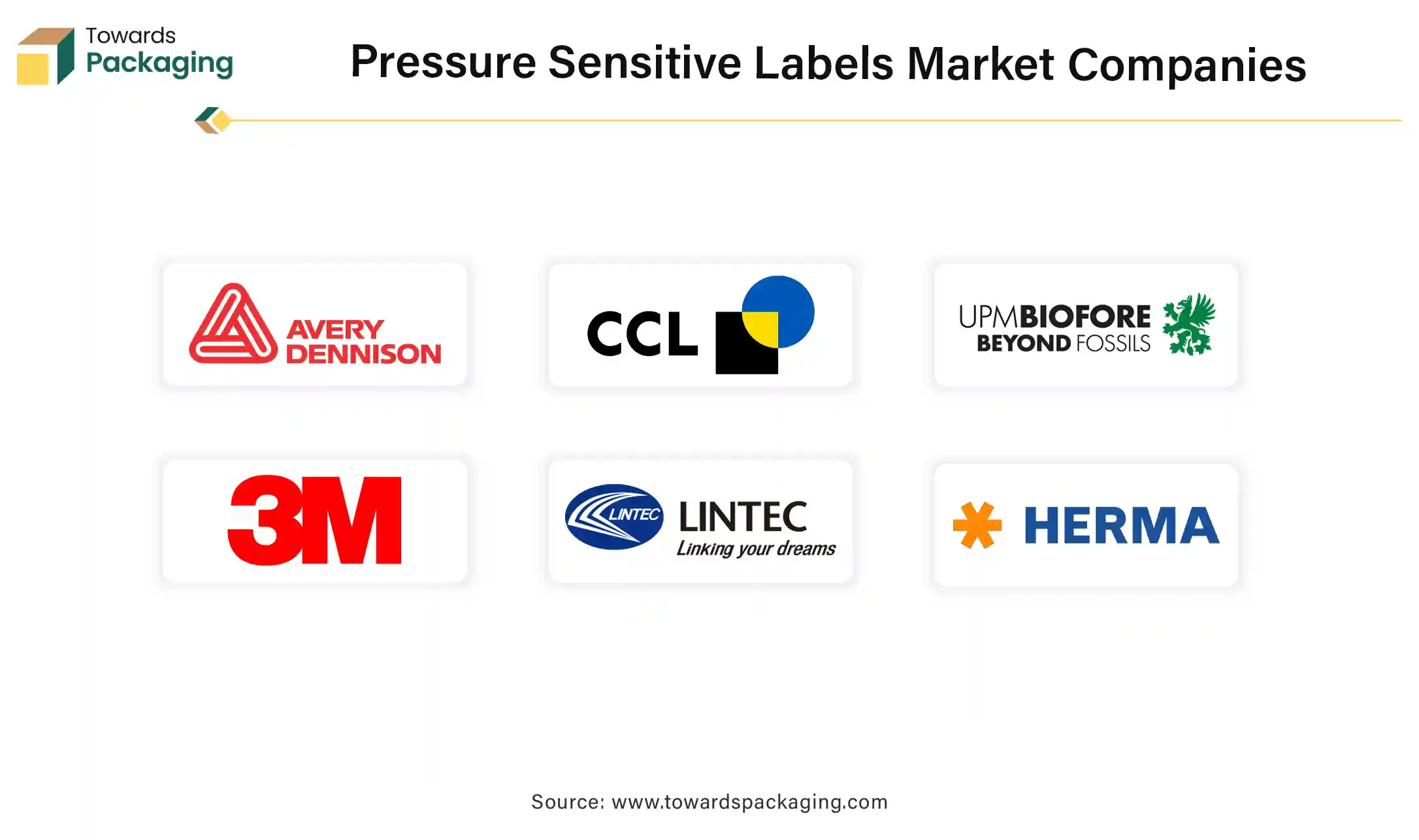April 2025
The global pressure sensitive labels market is estimated to reach USD 162.41 billion by 2034, up from USD 98.28 billion in 2024, at a compound annual growth rate (CAGR) of 5.15% from 2024 to 2034.

The pressure sensitive labels industry is projected to achieve remarkable growth over the forecast period. A pressure-sensitive label has three layers face stock, adhesive, and release liner. To generate a label material which can be imprinted on, laminated, die-cut, and then peeled off and attached to the product, all of these elements are sandwiched together throughout the manufacturing process. Over 80% of the labels supplied in the current market are pressure-sensitive labels, making them one of the most frequently utilized options. This is mostly because of how versatile they are. They are utilized in a wide range of products such as food containers, durable goods, toys, medical equipment, corrugated boxes, beer cans and bottles, plastic pouches, and much more. Furthermore, this sort of label works with a large range of printing technologies.
The expanding consumer goods and retail sectors along with the surge in the online shopping are expected to augment the growth of the pressure sensitive labels market during the forecast period. Furthermore, the technological advancements in digital printing as well as the push toward sustainability, as brands are increasingly adopting recyclable and biodegradable materials is also anticipated to augment the growth of the market. Additionally, the rise of smart labeling technology, such as QR codes and NFC-enabled tags along with the improved adhesive technologies to provide more versatile options are also projected to contribute to the growth of the market in the near future.
The growth in the pharmaceutical and healthcare sectors owing to the aging global population, rising prevalence of chronic diseases, and increased health awareness is anticipated to augment the growth of the pressure sensitive labels market during the forecast period. As per the Pharmaceutical Research and Manufacturers of America, in the United States, approximately 129 million individuals (i.e. 51.8%) suffer from at least one serious chronic medical condition. Furthermore, chronic diseases that may be prevented and treated are closely linked to seven of the most common reasons of death in the US.
In addition, a growing percentage of adult Americans suffer from numerous chronic illnesses; 42% suffer from two or more and 12% have five or more. Since chronic illnesses account for over 90% of the 4.5 trillion dollars spent on health services annually, they have a huge economic impact on the American healthcare system. By 2030, 83.4 million people are expected to have three or more chronic disorders, substantially increasing the financial burden that these illnesses place on society.

Nearly 1,181 medications are now being developed to prevent chronic illnesses. However, pharmaceutical and healthcare industries demand accurate, regulation-compliant labeling to guarantee patient safety, product authenticity as well as compliance with the stringent health regulations. Pharmaceutical products require labels that provide information such as dosage instructions, batch numbers, expiry dates and safety warnings making reliable labeling important. Since many pharmaceutical products have long storage lives or require special storage conditions, PSLs must be durable, resistant to moisture, chemicals, and temperature fluctuations, and able to withstand the environments in which these products are stored or transported.
The availability of alternatives such as shrink sleeves, wet glue labels and in-mold labels are likely to limit the growth of the market within the estimated timeframe. Wet adhesive labels are not just widely used in the beverage sector but they are also beneficial to the environment because they are simple to get off and don't leave any residue. They are also high-quality, water-resistant, flexible, and reasonably priced. Labels made with wet adhesive usually wrap a product bottle, can, or other container. It is a typical label material for plastic bottles, glass bottle and jars. Thus, for products like sauces, nutritional supplements, cannabis and CBD products, salad dressings, health and beauty items, beer bottles, wine, and spirits, among others, wet glue labels are ideal.
Furthermore, one more popular alternative is an in-mold label, which is melted on over the container during manufacturing, eliminating the need for lining or adhesive as needed in the case of pressure-sensitive labels. The ability to expose the label to various environmental conditions is the primary advantage of in-mold labeling. It is difficult to harm an in-mold label using physical handling, temperature, environment, or even the majority of chemicals. Another popular alternative is the shrink sleeves labels that are ideal for various shapes of containers, preserving the design integrity on the shelves. They also offer complete coverage, improving the visibility and brand recognition from every angle. These alternatives are appealing in the markets where specific functional or aesthetic requirements exceed the capabilities of the pressure-sensitive labels such as full-surface labeling, superior durability, or cost efficiencies for high-volume production.
The advancements in the printing technologies are projected to fuel the growth of the market in the near future. Innovations such as digital printing, flexography, and hybrid printing systems have revolutionized label production by offering improved precision, vibrant colors and cost-effective options. Digital printing is an innovative, adaptable, and growingly common technique for printing text and images on a variety of materials such as paper, plastic, and more. Digital printing transfers ink onto a substrate without the use of plates or screens, in contrast to conventional printing methods like offset printing for large quantities or screen printing. Rather, the printed text is sourced from digital data. New paper options have been made possible by the growth of digital printing. Now, there are many variations to choose from like matte, glossy, satin, and more, and the results are equivalent to offset printing.
Carbon balanced printing is another technology in the printing industry gaining traction created by a carbon balanced printer on the carbon balanced paper. With carbon balanced print, organizations may minimize (balance) the inevitable carbon footprint of their printed papers. It's an easy decision with big advantages. Since the printing sector contributes substantially to greenhouse gas emissions, carbon balanced printing helps minimize its carbon footprint, making it more sustainable. Additionally, carbon-balanced printing is more effective since it uses less energy during the printing process that eventually saves money. Also, innovations in the sustainable printing methods such as water-based inks and energy-efficient systems, corresponds with the growing demand for the eco-friendly options. These technological advancements collectively position the market for substantial growth by focusing on the efficiency, quality and sustainability.
The film/plastic segment held largest market share of 55.42% in 2024. The qualities and benefits of this material make it a popular choice to produce the pressure-sensitive labels. The material guarantees longevity and a neat, polished appearance while withstanding humidity, chemical substances, and temperature changes. The transparency and clarity of the labels created from this material are well-known. Due to their flexibility and resilience to tearing, they are perfect for applications that are subjected to harsh use. Polyester (PET), polypropylene (PP), and polyethylene (PE) are frequently utilized film materials. The increasing demand for flexible packaging options supports the growth of this segment, as these labels adhere seamlessly to irregularly shaped containers. Paper labels are likely to grow at a significant CAGR during the forecast period as there are numerous uses for these labels, and they the most economical.
The food & beverages segment held largest market share of 38.16% in 2024. This is due to the rapid expansion of the beverage industry such as the bottled water, soft drinks and alcoholic beverages. Furthermore, the increasing consumer preference for processed foods predominantly in the urban areas as well as the rising popularity of the ready-to-eat meals, snacks, and single-serve beverages is also expected to contribute to the segmental growth of the market. Additionally, the surge in demand for organic, gluten-free, and plant-based products along with the growing online grocery shopping and expansion of the frozen and refrigerated food segments is expected to support the growth of the segment in the global market.

Asia Pacific is likely to grow at fastest CAGR of 7.25% during the forecast period. This is due to expansion of industrial activities and urban centers. Also, the rapidly growing online retail market as well as the expanding food & beverage sector is likely to contribute to the regional growth of the market. As per the India Brand Equity Foundation, it is anticipated that the Indian food and beverage packaging market would rise significantly, from US$ 33.7 billion in 2023 to reach US$ 46.3 billion in 2028. Furthermore, the growing prominence of product information, safety and traceability by consumers coupled with the availability of low-cost raw materials and labor in the region is also expected to contribute to the regional growth of the market.
North America held considerable market share of 35.94% in 2024. This is owing to the presence of strong healthcare and pharmaceutical sector across the region. Furthermore, the growth of the e-commerce and retail as well as high consumer preference for aesthetically appealing and high-quality packaging is also expected to contribute to the regional growth of the market. Statistics Canada reports that in December 2020, e-commerce retail trade sales in Canada reached a new high of US$3.82 billion, surpassing the US$3.2 billion increase spurred during the coronavirus pandemic lockdown measures in May 2020. E-commerce sales reached over US$2.34 billion in March 2022. By 2025, retail e-commerce sales are expected to reach US$40.3 billion. Additionally, the adoption of smart labeling technologies along with the increased use in industrial applications is also anticipated to promote the growth of the market in the region in the near future.

By Material
By Adhesive Technology
By Printing Technology
By End-User Industry
By Region
April 2025
April 2025
February 2025
February 2025